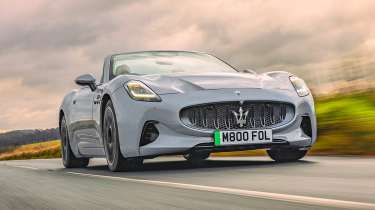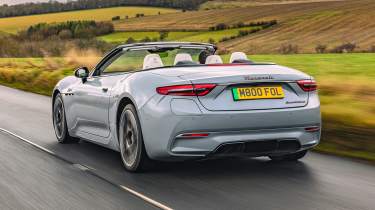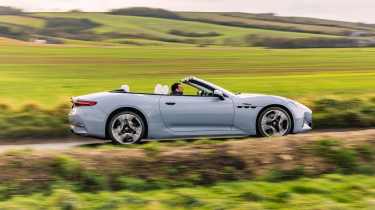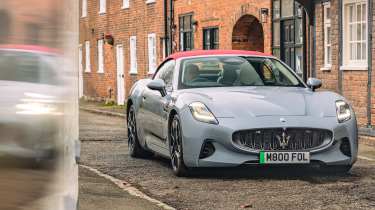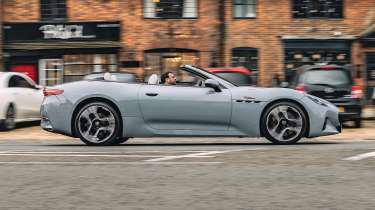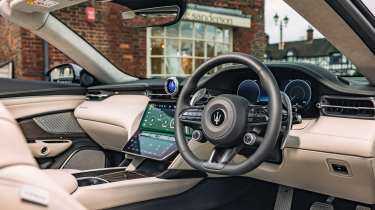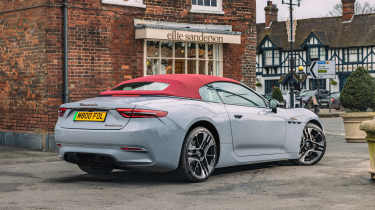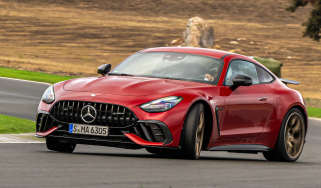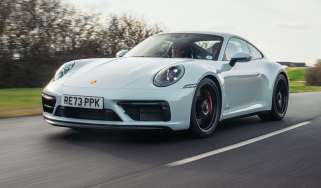Maserati GranCabrio Folgore 2025 review – an EV with emotion?
Maserati has been brave to go all the way in electrifying its range of grand tourers. Has that bravery paid off?
This is our first chance to try the all-electric Maserati GranCabrio Folgore on an extended test on UK roads, following a couple of briefer introductory drives on Italian soil, in prototype and production form.
That chance coincides with grim British weather; not exactly dream convertible conditions but even roof-up in a soggy Midlands car park, the GranCabrio still looks ineffably glamorous. The lengthy soft-top arcing over its four seats mimics the GranTurismo coupe’s fastback roofline, and the body beneath has the same coke-bottle contours and enormous one-piece clamshell bonnet. It carries just as much visual allure as its piston-powered stablemate.
The Folgore shares the same aluminium, steel and magnesium platform (and production line) as the V6 petrol versions of the Maserati GranCabrio and GranTurismo, with which it has been developed hand in hand. Power comes from three, 300kW electric motors, with total useable power output quoted as 560kW (or 751bhp), and torque a monster 996lb ft. A clever torque vectoring system works out how to apportion the three motors’ efforts: the front motor powers both front wheels, and the two rears split their efforts either side.
That gives the GranCabrio Folgore significantly more muscle than the 542bhp/479lb ft Trofeo petrol version, and it’s capable of markedly quicker acceleration than the V6 car, despite its 2340kg kerb weight. That’s about 445kg more than the GranCabrio Trofeo…
Having all that enormous torque on tap makes the Folgore truly, eye-wideningly, stomach-churningly quick. Acceleration is intense, particularly as you click the drive mode controller into its more sporting settings. That said, you do eventually get used to the sensation, and it becomes less shocking, and less addictive, through exposure.
More reviews
The rotary clickwheel on the steering wheel gives you four driving modes to choose from: Max Range, GT, Sport and Corsa. GT is the default median, and in this setting the GranCabrio is a smooth, urbane car to waft around in. Low-speed ‘throttle’ response is nicely calibrated, and it’s an easy car to manoeuvre in urban settings and car parks, despite its lengthy dimensions.
You can, however, sense that it’s not as torsionally rigid a car as the GranTurismo coupe. There’s a vaguely tremulous sensation which underlies the drive away from dual carriageways, accentuated by a visible vibration in the main rear-view mirror.
That said, primary ride from the adaptive air suspension is excellent, particularly in GT mode. The Folgore absorbs large bumps very well; it’s smaller-frequency bumps which make their presence felt.
It is of course a heavy car for the double-wishbone front, multi-link rear suspension to control. As a battery-powered EV, a four-seater and a convertible, the GranCabrio Folgore is off to the toughest possible start in life when it comes to weight. That said, whereas the petrol GranCabrio weighs around 100kg more than the petrol GranTurismo coupe, the GranCabrio Folgore is around 80kg heavier than its coupe equivalent as the battery pack itself has a stiffening effect, meaning less additional bracing is required.
The secondary ride smoothes out a little with speed and momentum, and in Sport mode, which stiffens the damping and lowers the air suspension’s ride height a little, it controls its body very well for a heavy car. Corsa mode sinks the ride height further (a process which takes a little longer to complete on a twisty road; it happens more swiftly in steady-state driving) and makes the suspension considerably firmer.
Max Range mode limits the top speed, the climate control’s power and softens the accelerator map, among other battery-saving measures. Power is limited in GT mode, too, to 80 per cent – which still makes this a thoroughly rapid car.
Sport mode allows full power, and relaxes the traction control a little (and it’s possible to manually switch off the stability control if you wish). Corsa loosens both traction and stability control further and gives a much more aggressive accelerator map, torque delivery and torque vectoring settings – which can be further customised through the touchscreen.
The Maserati is a very grippy car overall, and doesn’t ordinarily get out of shape without provocation. Its balance is most easily manipulated in slow corners, particularly during the cold, slimy conditions of our test. Thanks to a long wheelbase (nearly three metres) and 50:50 weight distribution, the balance is relatively predictable in tight turns.
It’s in faster curves where the Folgore can feel less natural; during one cambered, medium-to-high speed corner, there was an unpleasant feeling of torque-steer tugging at the wheel as the front wheels engaged on exit. That’s a sensation we’ve encountered in the petrol, also all-wheel-drive, GranTurismo during the 2023 evo Car of the Year test too, so it may not be a characteristic unique to the Folgore.
Overall, it’s a high-grip, relatively agile car considering its bulk, and one which disguises its overall mass as well as possible. Brake feel is always a subjective topic, and often the subject of criticism in cars like this which juggle electric motor regen and conventional friction brakes (the Folgore employs the same stoppers as the petrol Trofeo: six-piston calipers and 380mm discs at the front, and four-piston, 350mm at the rear). For me, pedal feel and consistency in the Folgore are impressive for a car of this type, especially considering the sheer mass at play, and pitch under braking is well controlled by the suspension too.
The long metal paddles behind the wheel, used for manual-mode gearshifts in the Trofeo, are instead used to toggle between four levels of regenerative braking in the Folgore, with up to 0.65g of deceleration from regen alone in its most aggressive setting. It’s an intuitive system that feels natural to use.
Refinement is impressive, particularly roof-up, where you’re nicely shielded from road and wind noise. Artificial sound – a deep-voiced, sci-fi-style note, which incorporates subtle synthesised elements of a Maserati V8 engine – accompanies acceleration in the sportier driving modes (at its loudest in Sport and Corsa), via the regular interior speakers plus dedicated speakers at the rear and on the exterior. Without the augmented sound, the motors are relatively quiet, emitting a soft but droney note which rises and falls gradually, almost akin to a CVT-equipped combustion car’s engine note.
The soft-top itself compromises boot space a little, and it’s not possible to lower the roof if you fill the luggage compartment. Although it is possible to store some luggage below the roof when it is stowed, you may be better served by placing it on the two rear seats, especially if you need to keep charging cables in the boot. The rear seats are tight for adults (though not as restricted as most 2+2 convertibles) but there’s decent space back there for children and child seats – though carrying a family’s worth of luggage is far from easy.
The Folgore loses a little more boot volume compared with the petrol GranCabrio, to package some elements of its EV running gear beneath the boot floor.
The soft-top hood is operated via the touchscreen, as are the majority of controls in the GranCabrio; you swipe along the screen to lower or raise the roof, a process which takes 14 seconds. The rear panel, beneath which the roof is stowed, opened with something of a jarring motion on our test car. Likewise, the hood itself operated with a slightly jerky pattern, and there were already a few crease marks visible at the folding sections of the hood.
That aside, the soft rooflining looks and feels suitably luxurious, as does the rest of the cabin. This test car has a bold white leather scheme for the seats, which include extra neck-warming vents just below the headrest to keep you warm with the roof down.
The driver’s seat can be positioned relatively low: the Folgore has a decently low-ish driving position for an EV, giving it the feel of a traditional GT car. That’s aided by the liquid-cooled, T-shaped battery’s spine-like positioning in the transmission tunnel area, with the top of the ‘T’ above the front axle. Official WLTP range is 277 miles, which limits the car’s grand touring credentials somewhat. However, 800V architecture does enable rapid DC charging, with the potential to add 100km of range to the battery in five minutes.
How you feel about the Folgore likely depends upon how strongly you consider a sonorous engine and country-crossing range to be part of the appeal of an open-air grand tourer. The Folgore has much of the feelgood factor of the Trofeo: it looks the part (with a choice of six wheel designs along with five roof colours), is capable of a rapid turn of pace and, dynamically, it can look after itself genuinely very well.
No doubt if you were to drive the Trofeo and Folgore back to back, the V6 car would be dynamically superior due to its lighter weight but the Folgore is an impressive engineering achievement. Its compromises over the Trofeo are kept to a minimum, but they are compromises nonetheless.
Price and rivals
The electric Maserati GranCabrio Folgore is more expensive than the petrol Maserati GranCabrio Trofeo, at £185,610 and £169,585 respectively at the time of writing (January 2025). Maserati’s all-electric luxury convertible is something of a first, and directly comparable rivals are scarce.
Bentley’s latest Continental GT is a hybrid, and like the Maserati is available as a coupe or as a drop-top in GTC form. Based on our first experience, it’s more enjoyable than the Maserati to drive with knock-out interior quality, although it weighs even more than the Folgore and costs considerably more, too. Despite its advancing age, the Porsche Taycan remains one of the benchmark electric cars for handling and driver involvement, iffy brake pedal feel notwithstanding. It’s a different proposition to the GranCabrio and GranTurismo, as more of a coupe-shaped saloon than a GT (and it isn’t a convertible, of course), with more practicality but less glamorous lines.
An unlikely entrant in the all-electric convertible field is the MG Cyberster two-seater roadster. It too occupies a different market to the Maserati, with a significantly lower price, smaller dimensions and a cheaper feel but it is a true all-electric sporting cabriolet. Based on our experiences so far, the Maserati has more stable, well-resolved ride and handling.
Regular Maserati GranCabrio rivals include the Mercedes-AMG SL 63 and the more expensive Aston Martin DB12 Volante and Ferrari Roma Spider.
